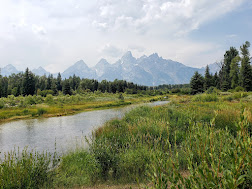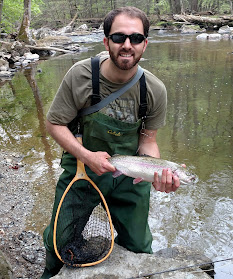If you’re like me, you spend more of your life around people who don’t fly fish than with those who do. I often find myself wrapped in a slew of emotions when confronted by the gulf between how others experience life and how I live mine, which is inextricably bound to my passion: fly fishing. Normally I can bear and process those emotions in silence, but when the other party, whether it be intentional or not, ventures toward diminishing my experience with phrases like, “It’s just fishing,” I have difficulty containing my frustration. In hopes of dispelling the dismissals of the unenlightened, I wanted to explore my own experiences with some of the many aspects of fly fishing that build up to the moments of tension and battle on the water, highlighting the culmination of a seemingly religious devotion that is much more than just fishing.
The Research
Simply grabbing a fly rod and heading to the water would seem nonsensical to most fly anglers. Before a wading boot is ever submerged, I’m taking significant time to research weather, flows, hatch charts, and local stream reports. If I’m exploring new water I’m doubling the time spent by researching wild trout reproduction maps, access points, and hatches specific to the water I’ll be fishing.
The Art of Fly Tying
An art form within itself requiring just as much time, patience, and practice as fly fishing, fly tying is an immersive and costly endeavor, but one in which many fly anglers take a great deal of pride, especially when looking in the net and seeing their handiwork embedded in the jaw of a fish. For me, fly tying is my sole creative outlet, my one form of artistic expression, and I value the many years I’ve spent learning and building my skills as a tyer while looking forward to everything I still have yet to learn.
The Gear
 |
| Three of my favorites. |
At the beginning of a fly fisherman’s journey, having a functional rod is the most important aspect; many beginning anglers go with the typical 9-foot, 5-weight (or the just-as-typical 9-foot, 8-weight for saltwater) paired with virtually any reel just to get a feel for the sport. As one progresses, though, gear selection becomes a crucial, time consuming, and often obsessive facet of fly fishing. Selecting a tippet size based on water conditions, fly size/weight, and fish behavior, choosing appropriate clothing and wading gear to match weather and terrain, purchasing just the right grain sink tip line factoring in depth, current, and fly weight, and fine-tuning the formula for one’s Euro leader are just a few examples of the exhausting measures to which a dedicated angler will go in order to increase the chance of success. For me, all of those factors and many more are considered, but the most important contributor to my enjoyment and success on the water comes down to the hardware in my hand. If I’m fishing a small mountain stream with dense foliage, I’m grabbing my short, 2-weight glass rod for tight spaces, small flies, and feisty little wild trout. If I’m fishing a bigger, lowland stream maybe I want my 10-foot, 3-weight Euro rod with a perfectly balanced reel or, if the flows are high and stained, my 6-weight streamer rod. Some fly anglers even go as far as to construct their own rods from scratch, starting with a rod blank and using thread, epoxy, and other adhesives to attach the guides, eyelets, handle, reel seat, and butt section all customized to their own specifications. As for the reel, drag system, weight, arbor size, and durability all factor into purchase and selection. There are truly an infinite amount of choices that go into any day on the water.
The Night Before
 |
| My tying desk for last minute prep. |
The night before any day of fly fishing involves a great deal of preparation. Gear selection aside, there is also last second tying, checking lines and leader, tying on fresh tippet, packing food, clothes, and gear, and then loading it all up in one’s vehicle so as to be on the road as soon as possible. While on the subject of waking, let’s discuss sleep. As a child, Christmas Eve was always my worst night of sleep in the entire year; the excitement and anticipation would keep me up, limiting me to maybe two hours of legitimate rest for the night. I no longer have this problem and often have to be dragged out of bed after oversleeping on Christmas morning, but the night before a fly fishing trip I toss and turn incessantly, my mind filled with the next day’s possibilities; for years I thought I was the only one, but I now know a number of fly anglers who struggle with the same childlike restlessness.
The Drive
 |
| My steed |
Some anglers are lucky enough to live close to quality fisheries, only having to drive a few miles, but most have to put in significant windshield time to pursue their favorite species. There isn’t a wild trout stream within 70-miles of my home, so I have no less than an hour (usually closer to two-hours) of driving ahead of me before I’m presenting flies to trout. While gas, tolls, and vehicle maintenance are costly, there is something to the drive that makes it an integral part of the mental preparation for what’s to come. Out of necessity, I fish early in the day and will often be on the road as early as 3:15AM, a time of darkness and somewhat empty highways. I set my cruise control, listen to a podcast, and drink my coffee as part of a routine that helps center me for the day. Fly fishing is extremely cerebral, requiring intense focus and patience and the baggage you bring with you on the water can greatly impact your success.
The Setup
 |
| I love setting up in the dark. |
Reaching the destination and setting up to head out is an important part of each trip. Making sure one’s waders and boots are snug yet comfortable for the trek ahead, rigging up rods and making those last second checks for weakness and imperfections, assuring that all necessary gear is present, functional, and easily accessible, and going over the plan for the day are all important parts of any day of fly fishing. My goal is to be ready to fish at first light, so I’m almost always setting up in the dark; to make things easier I’ve even installed multiple LED lights in the rear storage area and hatch of my vehicle.
The Trail
 |
| Trout don't live in ugly places... |
For any wilderness explorer, taking those first steps on the trail carry an electric level of excitement and it’s no different with fly fishing. Walking trails along rivers or stopping to observe the wildlife and scenery, a fly fisherman experiences the beauty of nature in ways that may have nothing to do with fish, but are no less special, whether it’s admiring the view of the Grand Teton range at a distance or taking the time to watch a fox cross the creek by trotting on a fallen tree. Sometimes it can be tense, such as those moments when bears are involved, but if you survive them you walk away with an unforgettable experience and a story to tell. I’ve mentioned this before, but when people belittle the impact that fly fishing has had on my life, I think of these moments and find myself replaying in my mind the lines from Rutger Hauer’s iconic monologue in the film Blade Runner: “I’ve seen things you people wouldn’t believe.”
The Handling and Release
 |
1st person view
of proper handling. |
Not all fly fishermen practice catch and release, which is fine as long as one stays within the law while not abusing the fishery (sadly it is possible to abuse a fishery while still acting within the law), but many stress the importance of proper handling and release as an integral part of preserving fisheries and regard watching a fish swim off healthy under its own power as one of the more rewarding and satisfying moments in a day on the water. Such handling and release practices include the use of barbless hooks and rubber-mesh nets as well as keeping the fish submerged while only handling it with wet, bare hands to face it towards the current in slower moving water until it’s ready to swim off on its own. Fly fishing photography is also an art form of its own, but when releasing fish, the photo should never compromise their health and safety.
The Bond Between Angler and Fly Rod
I take a lot of pride in fly fishing, its history, what it stands for and represents, as well as what I’ve been able to learn and achieve through it over the past twenty-plus years. Fly fishing is a fusion of art, science, and logic like nothing else in the human experience, requiring so much of a person’s being and energy; it’s also incredibly diverse, specialized, and ever-changing, making it impossible to master even if one had ten lifetimes to do so. When I’m walking along a river, rod in hand, I’m acutely aware of fly fishing’s past, present, and future as well as my own, recognizing the cork within my grip and the graphite extending from it as a crucial part of who I am.
The End (?)
Returning to my vehicle at the end of a long day, I usually find myself exhausted, dehydrated, and starving, mostly because I’m so focused on trout that I forget to eat or drink while covering miles and miles of stream. Weariness aside, while packing up and making the long drive home my head is filled with the day’s events; perhaps it’s excitement over a large wild brown netted or reflecting on a point in the day when faced with a clutch situation and having made all the right choices and moves. The reality is that just as often I’m thinking about the fish that popped off right at the net or the bow-and-arrow cast that went a foot too far, into an overhanging branch. Whether the scales dip more towards success or failure in a day, nothing changes my excitement for the next time I get to do it all over again and how thankful I am to have fly fishing in my life.

























